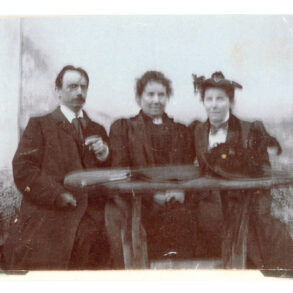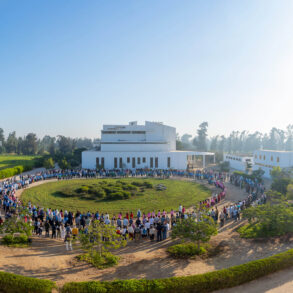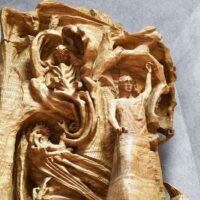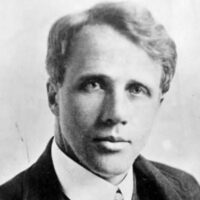A place where I enter into dialogue with art itself and a person who encourages this dialogue—an encounter with Joachim Eckl in Neufelden, Upper Austria.
The entrance is flanked by two silver tram carriages. Like entering a ravine, you step into “Die Station” (the Station) on the riverbank of the Große Mühl, the grounds of the old grain warehouse where HEIM.ART1 has taken up residence for a while—at least, for the time that the artist, art mediator, activist, and founder of the HEIM.ART label, Joachim Eckl, leaves his mark on this world. People keep wandering in, entering the grounds hesitantly, then venturing further—past the yellow New York taxi towards the golden ship, which played a role in a film by Visconti, to the ring of lanterns that Joachim calls “the Round Table”—and wondering what kind of place they have ended up in. Everything is a little ambiguous, at least at the beginning. Industrial wasteland? Art Museum? Hipster hotel? Private residence? Collector’s warehouse? Playground? Culture centre? This ambiguity is the best starting point for the events here that Joachim could ever wish for.
The reason for my visit to the Station in Neufelden Unternberg is a conversation I had with Joachim in Weimar before the coronavirus. He described his aversion to the perverted art market, in which works become mere commodities. He’d come up with a new idea of how works of art could be acquired, not for money but through conversations that open up a space for thought and perception, initiating an awareness-raising process for a limited time—initially, for as long as the piece speaks to you. So, when a flash of inspiration (an idea that stimulates me or stimulates the growth of my I) strikes me in a piece, I work for it, and I “acquire” it. If I have entered into dialogue with it, I am entitled to live with it for a while.
At the time, we were still fantasising a little and already envisioning seminar sessions ahead that could prepare new ground for art and aesthetic experience. Three years later, I set off past beautiful Passau to be warmly welcomed, like every person who ties up or runs aground here, to this cosy haven on the Große Mühl river. This is in part due to Joachim’s wife, Johanna, who is an incredible hostess.
Between Homeland and Art
Joachim Eckl studied psychology and political science. His approach to art arose from his academic work using pre-representational children’s drawings as a diagnostic tool. At that time, he noticed that a material form of expression is a clue that points to something invisible. For him, art and anthropology came together in the children’s drawings. He still loves them today. He looks after a collection of precisely dated drawings by a child whose father had the child draw every day from the age of 2 to 12. It’s an evolutionary series that may yet become a catalogue. “This is unique in the history of the world!” says Joachim enthusiastically.
After completing his studies, he worked for art professors, art productions, and as an assistant to artists. For example, in 1992, he created the “Puppy” flower dog for Jeff Koons in Bad Arolsen/Kassel that has stood in front of the Guggenheim Museum in Bilbao for many years, built one of Per Kirkeby’s brick sculptures, and helped realise a project for Christo. He also worked with and for Klaus Rinke for several years. Through these activities, he learnt a lot from the great artists and also gained experience of the stimuli driving the market. He saw art as a societal space of freedom, a space of possibility for human development—art as freedom to act. Joachim decided on a life with art, through art, for art, and ultimately by art. But he never wanted to make a living from selling his own works. There came a point when the art market disgusted him, and he returned to his homeland. His label HEIM.ART plays with this connection but it also plays with a person’s sense of being at home in art 2
Joachim is, first and foremost, an independent creator, then an artist and social sculptor who can move through the most varied spheres of social interaction with great ease. He is a force of will who is not deterred by the irrational, so he is actually also a kind of art entrepreneur. The old clock tower at Linz main station, for example, found its home in the HEIM.ART Station like this: Joachim was on his way to Vienna airport when he saw this clock tower—upon which thousands of pairs of eyes had seen the time every day—being demolished with a wrecking ball. Intuitively, without any plan, he abandoned his flight and made sure that the tower was relocated safely to his grounds. The cost of doing so was completely unclear, as was the purpose of the whole thing, but somehow he managed it. Today, you can enter the tower and look out through the “eye of time”, the hole for the clock hands, as if through a camera obscura, at the clock on the opposite warehouse, which appears inverted and upside down, moving your own consciousness. Today, he calls this work ”Timeless Watchman” [Zeitloser Wächter] and “Reversed Flow of Time” [Umgekehrter Zeitenfluss.]
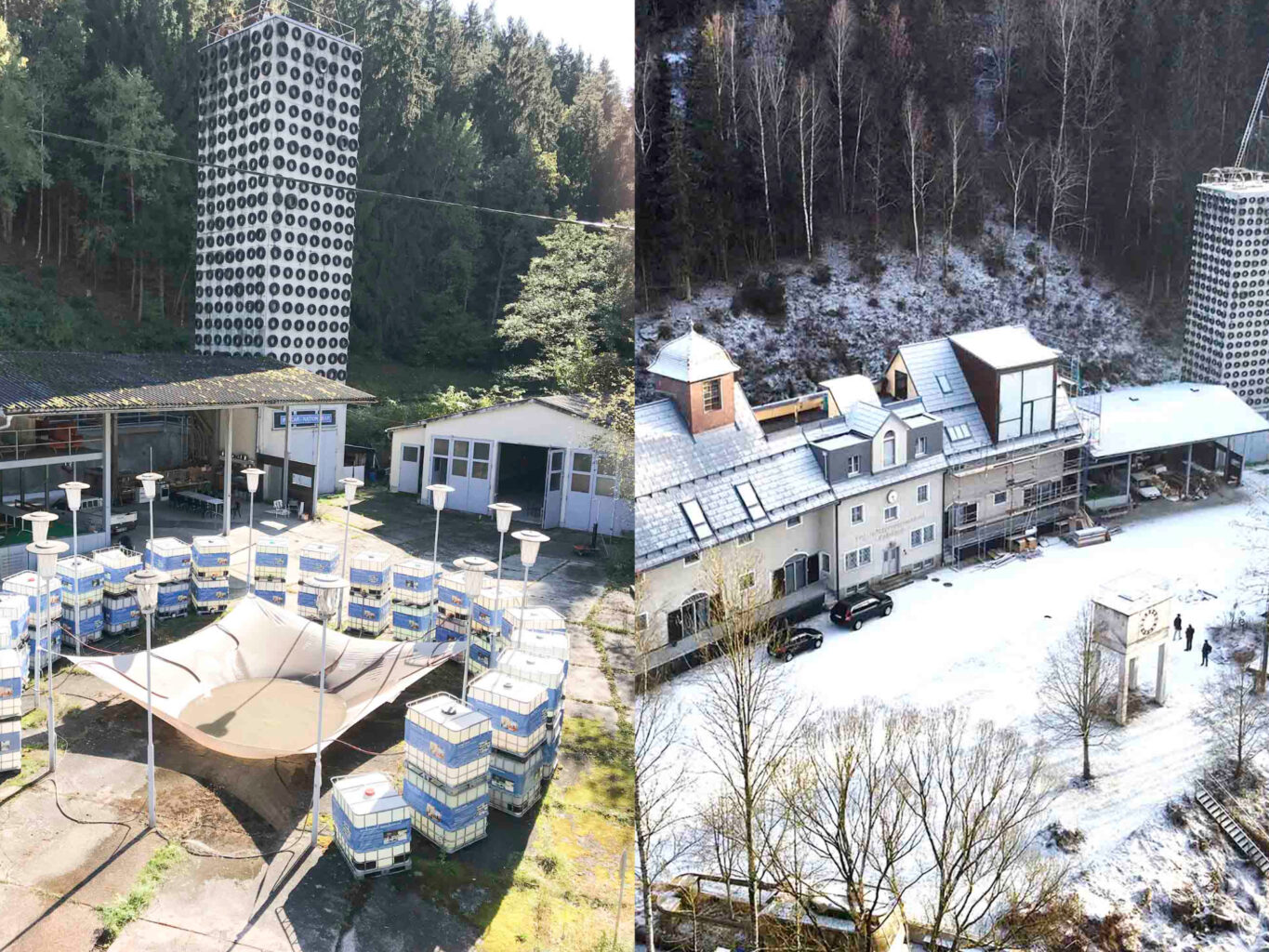
Travelling in Stationary Traffic
“Vehicle art” is a term that I encountered for the first time in Neufelden. It doesn’t mean tuning cars, but it explains why there are so many different chassis here. At the back of the large courtyard of the Station there is a tram from 1951 that can travel in both directions. Joachim often organises “trips in stationary traffic” with it. You sit together on imitation leather seats and are silent for a while. Sometimes, the carriages are full of clocks that have all stopped at different times. Some people travel into their past or begin to dream into their future, while others remain in the present. You share an experience that, in retrospect, serves as a conversation starter to exchange ideas about the spiritual relationship between yesterday, today, and tomorrow.
“You can’t develop directional forces without a past. But the root comes from the future,” says Joachim. At this point, his roots in Joseph Beuys’ world of ideas become tangible. For Joachim, “vehicle art”, in keeping with Beuys, means delving into works of art that allow us to travel in ideas. Through this extended concept of art, a different layer of the human image becomes clear to him in relation to his own inner self, the place where freedom can be found. Anthroposophy helps him gain a deeper understanding of this. “It’s a gold mine for me. It is a gift through which we can further develop our ‘being-in-the-world’.”
Almost all of his own artistic works have a social dimension, provide an experience, and combine this with a regional impulse. Be it his “ice pyramids” in Egypt, or the burnt-out boat in the gallery that “floats” on sand from St. Catherine’s Monastery at the foot of Mount Sinai, or the “tyre tower” in the Station itself that used to be the grain silo and now has 448 tyres that were removed from the cars in Neufelden in one year on the outside. In total, these tyres have driven 11 million kilometres, which corresponds to about 70 times around the globe or about 30 times to the moon. This was a project that worked with the image and concept of the “tyre” as an inner movement and creation of substance and the ecological dimension of our actions in local space. If you detach the concept of “tyre” [Reifen] from what you see when you look at the “tyre tower”, that is, if you think of it hieroglyphically, the concept “maturing” [Reifens] arises, which means reaching a higher state of being.3 Joachim put the grain from the old silo into the tyres as bird feed. Four pairs of falcons nest here in spring. In this way, the tower itself has matured, having been revitalised by art and taken on a new form of existence.
At first glance, I experience this place as a cabinet of art and curiosities. Then, it becomes clear: all the installations and works here are an invitation to a dialogue in which you can encounter intuition itself. “Intuitions need a protected space to appear, an interior space,” Joachim says knowingly, just as Beuys’ famous wooden box makes it clear— the box that Beuys produced 12,000 times. One of them is on display in the exhibition rooms here. Joachim sees the Station itself as a place where concepts can mature and come to life.
Drawing Water
Joachim Eckl’s favourite element is water. Some of his most important art projects, which he didn’t really promote in order to be free, have to do with rivers. The Große Mühl river in front of the house, the Danube not far away, and the river Nile in Egypt are, for him, the mobile and moving symbols of human creation. He often works with the visual language of reality.
Back in 2003, Joachim realised the “Watermark” project on his river here: “On each of the 60 kilometres of river of the Große Mühl, from its source to where it flows into the Danube, about 360 people drew water at 60 points at the same time. This joint action created a unique snapshot of the river.” The collective creation was the generator of this project, and that people really connect with their river. The water from this creation can be found as an installation in the Station. Next summer, together with Michael Pisaro-Liu, musician and professor at the California Institute of the Arts, he will perform a composition on the Große Mühl with 120 brass players to mark the 200th anniversary of Anton Bruckner’s birth. The piece by Pisaro is called “Melodic Currents”. Still poised in the future is a project along the entire length of the Danube as far as its estuary on the Black Sea—a “Danube Creation”. Joachim is quite trustingly patient and allows things to take their time.

Egypt
When you engage with Joachim, you can’t avoid another cultural region. It is his inner adopted home. Joachim lives very much connected to the mythical images, concepts, and culture of ancient Egypt. “The Egyptian concept of time was characterised by continuity and recurrence,” he explains. One of his great Egyptian insights is that continuity is a unit of time in its own right, a form-generating time element. Something takes shape, and that just takes as long as it takes. His “Ice Pyramid” takes as long as it takes. Even once it has melted, it is still there. An image that I have “acquired” within me also continues to exist because I continue to carry it within me.
The Egyptian principle or image “Sema Tawy” has also become the expression of a living idea for him. It is the connection between the two kingdoms of Upper and Lower Egypt, represented respectively by a papyrus and a lotus plant. The life currents of the two realms intersect and fertilise each other in a breathing connection. That is the same for Joachim in art—it breathes both in the spiritual and in the world.
Panopticon of the Imagination
In his work, Joachim Eckl strikes me as a bit of an alchemist, a converter or transformer of substances. For him, art as a field of work is the fertile ground in which we can develop spiritually and personally, for ourselves and for the world. With art, people always reveal something about themselves as well. For Joachim, it is all about giving art and people a home, in the sense of putting down roots. And he never means that in an abstract way. “Being at home happens in two directions: downwards, in the sense of origin and history, and upwards to the world of ideas and the spirit. The moment I learn something about art, I experience the guiding forces that, as a spiritual impulse, evoke a form of cultural identity in the sense of growth of the I. I move, for example, from the ‘either-or’ to the ‘both-and’ when I have raised this connection to my consciousness, mediated through art. I then experience what is timely in a culture. Art carries me into a consciousness that is different from the ordinary or scientific consciousness. It is an evolutionary impulse for development and growth of the I, a body of memory and remembrance, a repository and seed of ideas.”
Joachim sees himself as a mediator of these connections. And mediation is communication. Its destiny is to have one foot in and one foot out.4 It is a bridge. And so too is Joachim. His mediation has a value that lies beyond price, that is difficult to measure monetarily, even if a donation of 20 euros per person is suggested for guided tours through the panopticon of the imagination in the Station. But there is plenty of material here to stimulate you and your thoughts. The host himself could pass for an imagination—what for, is up to each visitor to find out for themselves.

Homecoming
“So, where does art take us?” Joachim sometimes asks the guests after a tour. To the centre of being human and to ourselves. Michaela Haider, aka Lia Niobe, a young photo artist whose work can be found in the HEIM.ART gallery, happens to be present during my visit. She was involved as a pupil in the “Mozart Digestion” and “Upstream Drift” projects. She recounts: “The Station gave me access to art and an understanding of art as early as the age of 6 to 10 when we did projects with Joachim. It was a real homecoming. Above all, the encounters and conversations with the people who come together here time and again have left a strong impression on me. There was, and always is, a depth that arises in the exchange, from which I can draw strength, which is made possible and opened up by the place. Engaging with the works, ideas, images, the work and concepts locally has enabled me to categorise and connect many things that I encounter elsewhere. Above all, it has also provided impulses for my own work that have led to a deeper examination and strengthened the foundation from which my pictures are created. The encounter with Joachim and HEIM.ART as a place has taught me about the nature of art and creating art, allowed me to find a more focussed form for my own work and created an understanding of why artistic work is needed in the world.”
We are not talking here about art as a sector. Joachim means it more comprehensively, as a path of the human being, as a path to the spiritual. “There is no art without people; it is only there for people. But people are also responsible for the spiritual world. Art is our toolbox, where we engage with imaginations, inspirations, and intuitions. It allows us to become something that we could not become without it. It enables us to encounter ourselves. The ‘Venus of Willendorf’, for example, is among the first evidence of the human being experiencing themselves face-to-face as an ‘I am I!’.”
The answer to Joachim’s question as to where art leads us is not absolute. Like the question itself, it is an invitation, perhaps even to self-knowledge, but that is left to everyone’s own discretion. There will always be something left unanswered. This inspires us to continue creating, making, forming, speaking, and marvelling. And this residual part is more important to Joachim Eckl than any accomplished and praised artistic work of his own. In Neufelden, he has created a place where the questions themselves live and inspire, where notions can emerge and play out in our consciousness. That he maintains this state seems to me to be a cultural impulse that is very promising for the future.

Bottom right: Joachim Eck, photo: Gilda Bartel
Translation Christian von Arnim
More heimart.at
Footnotes
- HEIM.ART is an expression coined to play with the regional sound and meaning of the German word for homeland: Heimat.
- see footnote 1.
- Translator’s note: this is a play on the German word “Reifen”, which can mean both “tyre” and “maturing.”.
- This is a thought that Wolfgang Held recently shared at our editorial meeting. Thank you for that.



